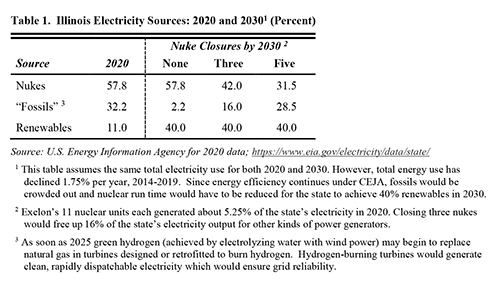
WILLIAM RAU
- Sets a target of 40% renewable energy by 2030 (“40 by 30”), up from 11% for 2020
- May force fossil-fueled electricity out of the Illinois market by 2030
- Extends efficiency programs to sustain cumulatively-significant cuts in total electricity use
- Funds a five-fold expansion – from $10 to $50 million annually – for low-income solar
- Creates a Green Bank to backstop billions in private equity green investments while providing loans for businesses in low-income communities
- Allows utility customers to fully fund efficiency upgrades from savings on utility bills
- Mandates prevailing wages for most renewable energy projects
- Opens 13 clean energy job training hubs
- Grants up to $40 million yearly for communities losing a power plant or coal mine
- Has extensive equity provisions for low-income and minority families and communities
- Subsidizes three more of Exelon’s nuclear power generators
Missing above are programs to electrify transportation and increase grid integration and energy storage. CEJA was a 956-page bill because no-exceptions decarbonization of all Illinois electricity generation was only one of its goals.
However, there are the IFs. IF renewable energy generation increases to 40%, IF heavily-subsidized nukes still control 58% of total electricity generation (Table 1), and IF efficiency programs continue to reduce total energy use, all fossil-generated electricity will not only be forced out of the market earlier than mandated, but nukes will face renewables in a zero-sum game. Between 2014 and 2019, the Illinois economy grew 3% per year while total electricity use declined 1.75% per year. If the size of the energy pie continues to shrink through 2030, there will not be enough pie left to feed both 11 nuclear units and expanding wind and solar farms.
There’s more. American nukes, designed as always-on generators, ramp up and down slowly compared to fast-changing renewable generation. The two won’t mesh in a production duopoly. Nuclear inflexibility could be managed with CEJA’s grid integration and storage plans, if the growth of storage, demand response, etc., is fast enough. If not, CEJA will halt development of renewables because “reducing carbon dioxide emissions must not threaten electric reliability” [Sec. 4-605]. The law therefore mandates a “reliability mitigation plan” allowing generation from “large greenhouse gas emitting units” if they are “necessary to maintain power grid supply and reliability” [Sec. 9.15(k)(1)]. CEJA’s immediate concern involves Central Illinois where accelerating closures of coal-fired plants might result in Central Illinois electricity shortages by mid-decade. Next, a nukes-renewables duopoly could create state-wide reliability problems before 2030.
Is CEJA building an energy house that cannot stand?
It depends, and some major “dependencies” are not due to CEJA. (To be continued in December column.)


1 comment for “Heat Waves — In Red and Black | The Clean Energy Jobs Act: Will Illinois Achieve “40 by 30”?”